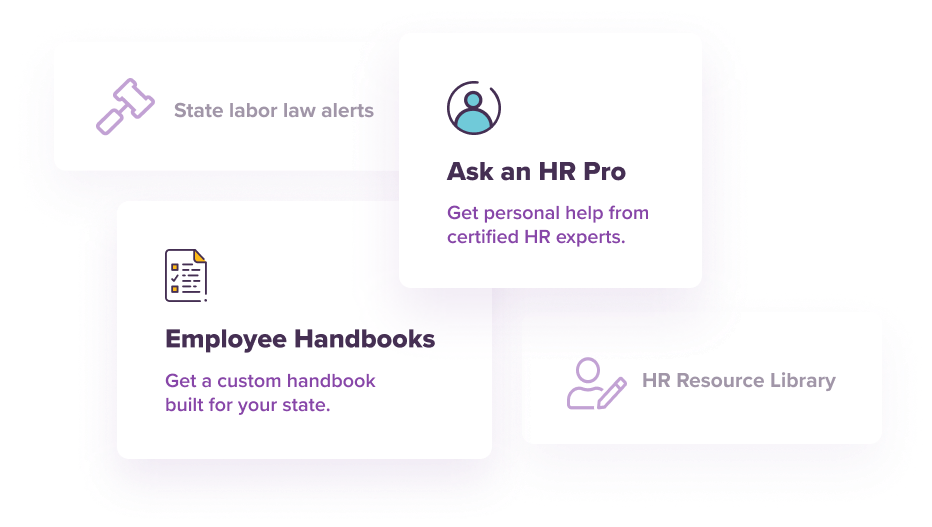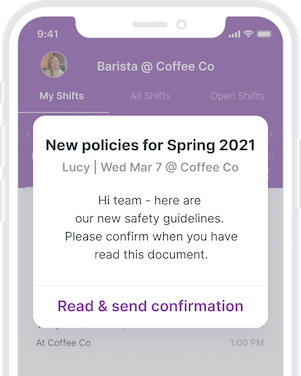Workplace safety tips for your small business
- Workplace safety refers to the health, safety, and well-being of your employees when they are in your work environment.
- There are many OSHA rules you must follow based on your industry that help you create a workplace free of danger.
- Homebase HR Pro can answer questions you have around workplace safety and help your create policies that help prevent injuries on the job.

What is workplace safety?
Workplace safety refers to the health, safety, and well-being of your employees when they are at your work environment. Workplace health and safety culture can include preventing workplace injuries by eliminating unsafe working conditions and recognized hazards, implementing a safety program, and posting workplace signs that alert employees of danger.
Employers are required to follow federal standards or regulations under the Occupational Safety and Health Act (OSH Act). The Occupational Safety and Health Administration enforces and monitors workplace safety on the national level, and exemplifies three goals to promote safe and healthful workplace environments:
- Improve the safety and health for all workers, as evidenced by fewer hazards, reduced exposures, and fewer injuries, illnesses, and fatalities.
- Change workplace culture to increase employer and worker awareness of, commitment to, and involvement in safety and health.
- Secure public confidence through excellence in the development and delivery of OSHA’s programs and services.
Additionally, businesses that provide thorough safety policies can benefit greatly in terms of insurance. Workers’ compensation insurance premiums are determined by payroll, occupational classifications, and workplace injury history. Businesses that have a higher rate of accident history typically pay a higher premium than the average industry rate.
If your business has a low injury rate, you could potentially pay a less expensive premium than the average rate in your industry.
If you need to implement workplace safety policies that follow OSHA guidelines and labor laws into your employee handbook but don’t have a small business HR team, Homebase HR Pro can help. Our certified HR experts can help you create new policies and review your existing ones to make sure your providing the best environment for your team.

What are a few examples of workplace safety topics?
When implementing a workplace safety program or safety meeting series, consider touching on the following topics:
- Personal safety equipment provisions
- Mechanical aid training
- Equipment control installation
- Operational manual creation
- Establishing emergency exits and procedures
- Providing regular breaks for hazardous jobs
- Informing employees on warning signs
- Enforcing a policy on how to handle hazardous materials
- Implementing training programs
- Establishing a drug and alcohol testing policy
- Offering employee counseling
Are you unsure about how to create a training policy for your industry? Homebase HR Pro offers on-demand trainings so you can learn how to provide the right information to your team. Our certified experts will also review your policies and help you make new ones.

Barzotto
Marko Sotto
Owner at Barzotto

What are the OSHA workplace safety rules?
There are many OSHA rules you must follow based on your industry that help you create a workplace free of danger. First, you must report all injuries and incidents, including deaths, to an OSHA office near you. You can learn more about the reporting requirements on OSHA’s website.
You also must provide certain types of trainings to your team. If you have less than 10 employees, they may be done orally. However, if you have 10 or more employees, a training plan must be written and kept in a visible area for employees to view.
Hazardous substances
You must inform workers on how to identify hazardous substances and train them on how to treat any injuries that may occur from those materials. It’s important to know that although you might not deem a material as hazardous right away, the government could think otherwise.
Any substance that could cause harm to an employee, both injury or illness, is considered hazardous. These can range from toxic or flammable substances in a warehouse to seemingly mundane chemicals in a normal office setting such as cleaning supplies that contain bleach.
You are required to obtain the Material Safety Data Sheets of all hazardous materials from the substance manufacturer. You can use this database to look for the sheets you need. The sheets must be kept in a place where employees can easily access them, and you must also train employees on how to locate necessary information on how to treat injuries from the pages.
First-aid/bloodborne pathogens
Employers are required to train workers on how to administer first aid and protect themselves from bloodborne pathogens at work. Blood-borne pathogens are diseases that are transferred through human blood and bodily fluids. The most common of these diseases are Hepatitis B, HIV, and Hepatitis C.
If you employ medical workers, emergency professionals, or any other employee who has “occupational exposure” to blood-borne pathogens, you must provide blood-borne pathogens training to them. Still, all other workers should be given the training as well as part of their first aid training in case of an emergency.
Fires and emergencies
Make sure your employees know how to evacuate the building safely in case of fires or other emergencies, as well as how to use fire-fighting and personal protective equipment. If you need help deciding on the best exit route for your building, consult the OSHA Emergency Exit Routes Fact Sheet.
There are also state and local laws regarding workplace safety, so take a look at your state labor law guide to learn more. And if you need help understanding other laws in your area around topics like employing minors, FLSA, FMLA, blue laws, wage and hour laws, minimum wage, employee rights, and more, Homebase HR Pro’s certified experts will answer any questions you may have when you sign up for an account.

Do I need to post safety signs in the workplace?
OSHA also requires you to post an OSHA-compliant poster in a prominent place so all of your employees are aware of their rights. Click here to download your free federal OSHA “It’s the Law” poster.
If new signs are released in your industry, Homebase HR Pro will send you an alert and let you know when the new sign needs to be posted to remain compliant. Get started with HR Pro today!
